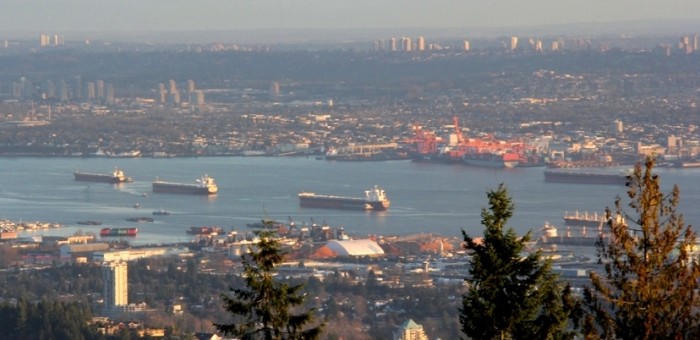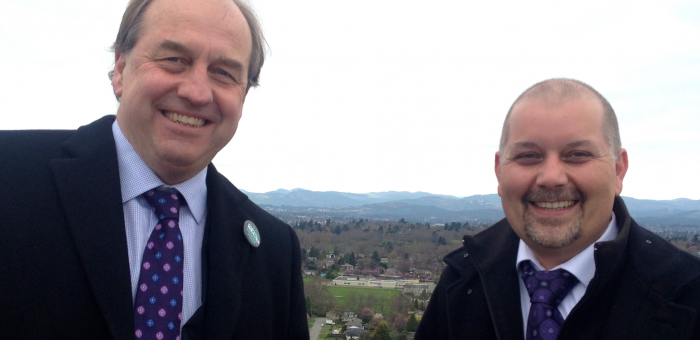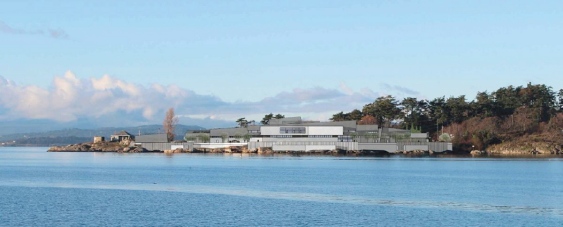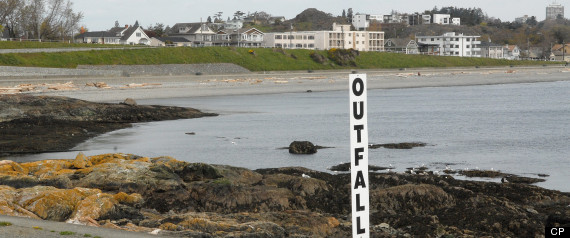Andrew Weaver spoke today at the Union of British Columbia Municipalities Convention in Vancouver
Andrew Weaver — UBCM Speech
September 19, 2013
Two years ago, if someone had said to me that I would be standing before the UBCM as Deputy Leader of the Green Party of BC and elected MLA for Oak Bay Gordon Head, I would have told them that they were crazy. But here I am, and what a thrilling journey it has been.
May 14, 2013 saw a change in BC’s political landscape. It saw the emergence of another choice for the voters of British Columbia. The Green Party of BC offers British Columbians a new vision for our future — A vision that transcends the traditional political boundaries spanning the right versus left spectrum. It is a vision for a compassionate society that lives within its means while preserving the environment around us. It is a vision that guides us to think about the long-term consequences of the decisions we make today.
The transition from scientist to Green Party of British Columbia politician hasn’t been as difficult as I thought it would be. In science, we identify a problem or challenge and seek a solution to that problem or challenge based on the available evidence. We don’t start with the solution and seek evidence to support it after the fact.
The Green Party of BC is a solutions-oriented party — one that fundamentally believes that policy should flow from evidence. I like to call this evidence-based decision-making, as opposed to what happens too often in politics today — decision-based evidence making.
For the Green Party, being a member of the opposition is about more than opposing government policy for the sake of it — it’s about addressing the issues and working in a non-partisan fashion to advance good policy.
The fact is, very few of the important challenges facing our society can easily be placed within the traditional left-right political spectrum. Addressing these challenges requires us to come together from across the political divide. It requires us to cooperate and collaborate across all levels of government. And it requires us to develop a social license before, not after, a policy pathway is chosen.
The Green Party of BC believes that small business is the engine of our economy. We believe that basing budget projections on hypothetical LNG revenues is to risk subjecting BC’s economy to the boom and bust roller coaster of global fossil fuel pricing, with all its twists, turns and drops. To attempt to lay all our eggs in this one basket, in the hope — the desperate hope — that we will be the one exception — the one jurisdiction that will defy history and economics— is to base our future on very unstable ground.
Yet even if we defy the odds and coast through the boom and bust cycles, we cannot achieve our provincial greenhouse gas targets while we double down on LNG. We will have no choice but to abandon our continent-leading climate commitments. That’s not politics — it’s science. And the numbers just don’t add up. The greenhouse gas emissions associated with LNG development are simply too high to allow us to meet these targets.
I believe our province is headed in the wrong direction, and it is up to us to redirect its course. We’re following a path fraught with risk. It’s a pathway that puts the interests of major multinational energy corporations motivated by short-term profit ahead of British Columbians and their long-term interests. My question to you is this: Will BC’s hypothetical, risky adventure into LNG actually benefit your communities in the long-term? I think not.
And I think talk of BC becoming a major LNG exporter is nothing more than a pipedream.
Canada has less than 1% of the world’s proven natural gas reserves.
Russia has about 20 times as much natural gas as all of Canada combined and recently signed long term export agreements with China. Russia can transport its gas to China via pipeline and does not need to undergo the costly process of liquefying the gas for tanker transport.
Australia has similar-sized shale gas reserves as Canada and is much further ahead in the development of its LNG industry. Yet several of their new projects have been put on hold citing concerns over cost.
The United States has more than twice the shale gas reserves as Canada and the US government recently decided to allow natural gas export. The US already has some of the necessary infrastructure in place on their coastline to facilitate a relatively quick development of an LNG export industry.
China could soon be well positioned to take advantage of its own natural gas reserves, which are 3 times the size of Canada’s.
The fact is, we need to grow and stabilize our economy. But the government’s solution will not do this — it will not address this economic challenge. Nor will it address the challenge that Stephen Lewis just yesterday described as the greatest threat that we face today — climate change.
So here’s another solution. We don’t have to go all in and then double-down on LNG. We could invest in the economy of tomorrow instead of the economy of yesterday. We could follow the leadership of Germany, California and now the United States as a whole or even China. We could position ourselves as leaders in the clean tech sector – the sector responsible for the generation, transportation, storage and end-use of renewable energy. This is a sector that creates stable, high paying, jobs in communities throughout British Columbia, not just in one or two locations.
We already have the industry, the expertise and the capital, and we were once considered emerging leaders in this area. But now what we lack is clear government leadership. In the US, for example, job growth in the clean tech sector is growing at four times the rate of all jobs. And that’s a Jobs Plan you can take to the bank.
Stable, local jobs give rise to vibrant, resilient municipalities. Yet, building strong municipalities is about more than making smart economic choices at the provincial level. It is also about ensuring that municipal governments are empowered to make the investments their communities need. It is about asking ourselves: “How do we finance our municipalities now and how might we better finance them in the future”.
No one knows this better than our new interim leader, Adam Olsen, a former municipal councilor from Central Saanich.
The Green Party of BC is delighted by the unanimous UBCM vote yesterday in support of the Strong Fiscal Future Policy Paper. We also believe that it’s critical to immediately initiate a provincial dialog on the future of municipal financing. Is continuing to burden homeowners with property tax increases year after year really the best approach? Or, could provincial and municipal governments instead work together to create a more progressive financing system that promotes, instead of impedes, the type of fundamental economic activity that we all value, such as buying a home.
I’m asking everyone in this room to consider working together to find real solutions to the important problems that face us today. When Stephen Lewis says that we have the most lunatic political culture in Canada we all laugh. But quite frankly, I think we should all be ashamed.
While I may disagree with the government in their approach to LNG, I am committed to work with them to find more practical solutions for the betterment of all British Columbians. There is a lot of work to be done and a lot of potential to be realized. But together, we can move our communities forward by investing in stable, local jobs and strong municipal governments.
Achieving this goal requires hard work and cooperation across all levels of government, willingness to work across political differences and a focus on evidence-based decision-making. It’s not going to be easy, but it is possible. Together, let’s forge this path to the future.
Thank you and thank you to the UBCM for giving me the opportunity to present to you today.
Media Statement – Andrew Weaver calls for moratorium on dilbit tanker traffic from Burnaby port
Media Statement—September 19, 2013
For immediate release
Vancouver, BC: Andrew Weaver calls for moratorium on dilbit tanker traffic from Burnaby port.
The British Columbia government has rejected the proposed Northern Gateway pipeline due in part to inadequate preparedness for potential marine and land heavy oil spills, while ignoring the fact that the heavy oil, diluted bitumen (dilbit), is shipped weekly from Burnaby, posing serious risks to BC’s coast.
“I am calling on Premier Clark and the BC government to be consistent in their approach to standing up for BC by placing a moratorium on all dilbit tanker traffic on our coast, including existing and proposed traffic from the Trans Mountain facility in Burnaby.”
The government has made it clear that any heavy oil pipelines and tanker traffic along the BC coast must meet 5 basic criteria, including world-leading marine and land oil spill response and recovery systems.
Meanwhile, documents from the Department of Fisheries and Oceans identified that: “Behaviour models specific to dilbit spills do not exist, and existing commercial models for conventional oil do not allow parameter specific modifications.” In short, should a spill occur, the research, data and evaluation of the effects of dilbit on land, fresh water and marine environments are simply not available, neither are the procedures, protocols, equipment and expertise that will be required to respond. A dilbit spill in Vancouver harbour would have profound and long-lasting consequences.
In its thorough submission to the Northern Gateway Joint Review Panel the British Columbia Government stated: “the Province is not able to support approval of the project, and submits that its concerns respecting NG’s ability to respond to a spill should be given serious consideration by the JRP”.
However, while the government has made a strong case against dilbit exports from the Northern Gateway pipeline, it has failed to address the very real threat that existing dilbit tanker traffic from the Trans Mountain facility in Burnaby already poses to the BC coast. Currently 5 tankers pass through the harbour each month carrying dilbit, a number that could increase dramatically to 34 with the proposed twinning of the Trans Mountain pipeline. If the proposal is successful, the Trans Mountain pipeline will transport 890,000 barrels a day, making it nearly double the capacity of the proposed Northern Gateway pipeline, which would transport 525,000 barrels a day.
Join Andrew Weaver at the Walk for Reconciliation in Vancouver
On Sunday I will be joining Canada’s first Walk for Reconciliation in Vancouver.
The walk has been organized by Reconciliation Canada, an organization dedicated to supporting all Canadians – indigenous and non-indigenous alike – to renew relationships, based on a shared understanding of our histories and our cultures. Reconciliation Canada was born from a vision of Chief Dr. Robert Joseph, Hereditary Chief of the Gwawaenuk First Nation and was established as a collaboration between the Indian Residential Schools Survivor’s Society and Tides Canada Initiatives Society, in order to initiate a dialogue among indigenous and non-indigenous peoples on reconciliation and on walking a better future together.
The Walk for Reconciliation is the final event of Reconciliation Week Vancouver 2013 and aims to demonstrate our joint commitment to build better relationships to achieve resilient, sustainable communities.
I invite you to join me as I proudly walk together with Tsartlip First Nations member and Interim Leader of the Green Party of BC, Adam Olsen, as well as Green Party MP, Elizabeth May and Vancouver Green Party City Councilor, Adriane Carr.
For more details please visit Reconciliation Canada’s official website: http://reconciliationcanada.ca/participate/walk-for-reconciliation/
CRD Sewage Treatment Plan: Facts and Comments
Facts and Comments
Fact 1: The CRD’s proposed $783 million secondary treatment system involves building a single facility at McLoughlin Point. The biosolids would be transported over 17km in a newly constructed pipeline to the Hartland dump where resource recovery (energy production) is expected to occur. A significant component of the overall cost is associated with the construction of this pipeline.
My Comment: The high costs associated with constructing the pipeline between McLoughlin Point and Hartland dump are unnecessary and could be significantly reduced. For instance, the Federal government could allow the biosolids to be processed at Macauley Point on the vacant Department of National Defense land, rendering the pipeline significantly shorter. Alternatively, several proponents have requested a more distributed model that would allow local municipalities to address sewage treatment as they see best fit for their jurisdictions. Such systems could incorporate tertiary sewage treatment and therefore also address the real problems of marine toxins. These are just two examples of other viable options to save taxpayers money and better address the real issues from sewage.
Fact 2: The CRD proposal includes a redesign of the system so that the Oak Bay storm water/ sewage common pipe usage would only lead to raw sewage overflows on local beaches during rain events that, on average, occur once every 5 years.
My Comment: We live in the context of a changing climate with projected increases in extreme rainfall. The events in Calgary and on the east coast of the United States are just two examples of this. It is well-known that the frequency of extreme precipitation events will go up as the world continues to warm from increasing greenhouse gases. As such, rain events that currently occur once in 5 years, will likely occur more frequently, thereby rendering the current plan possibly insufficient.
Fact 3: The sewage treatment plan is funded jointly by the CRD, the provincial government and the federal government, and therefore has to factor in deadlines from each level of government. The CRD was originally mandated by the Provincial Government to implement sewage treatment by 2016 and continues to operate under this deadline. The Federal Government has set its deadline at 2020. In answers to questions I posed during the July 2013 provincial budget estimates, Minister of the Environment Mary Polak opened the door to extending the current 2016 completion date with a formal request from the CRD. This would allow for plans and construction to formally be pushed to the federal deadline of 2020, or potentially even longer if both levels of government were convinced a new proposal offered greater benefits. In addition, Minister of Community, Sport and Cultural Development Coralee Oakes noted that the government is also open to a request from the CRD for extending funding. At present $248 million is not going to be realized until the 2017-18 and 2018-19 fiscal years.
My Comment: There seems to be an unwillingness to reconsider the current sewage treatment proposal because of a perceived need to meet arbitrary deadlines. I call these deadlines arbitrary because it is within each government’s power to change those deadlines should they see fit. For instance, delaying the sewage treatment deadline to the federal government’s 2020 deadline would allow sufficient time to reconsider the current proposal in light of its shortcomings in order to find a more cost-effective solution that also addresses the problem of marine toxins.CRD Sewage Treatment Plan: Facts and Comments
My Assessment
Victoria clearly needs to deal with its sewage. We are dumping raw screened sewage into the ocean and that is unsustainable. However, the proposed solution appears rushed and constrained to meet completely artificial timing deadlines put in place by politicians and government bureaucrats. The question is not if we need sewage treatment but rather if there is something that can be done better given a little more time.
I would like to see municipal, provincial and federal governments agree to a 2020 deadline for implementation of sewage treatment. It is important that we build a system for the future using the latest technology and not a system from yesteryear that doesn’t actually address many of the environmental and fiscal sustainability issues we face. I would want to see an integrated liquid and solid waste management strategy put in place that includes a thorough examination of distributed systems, exploration of public-private partnerships, and industry led solutions.
CRD Sewage Treatment Plan: Background
The Capital Regional District (CRD) is currently considering a proposal for a $783 million sewage treatment facility at McLoughlin Point. This page will provide a concise overview of the issues surrounding sewage treatment and explain why a proposal is being considered. It will also highlight some of the concerns that have been raised about sewage treatment and the current proposal.
At present, Victoria is dumping raw, screened sewage into the Strait of Juan de Fuca. Such sewage contains a mixture of organic waste and marine toxins (pharmaceuticals, fire retardants, other toxins etc.). About 50% of the marine toxins are attached to the biosolids, the other 50% are mixed in with the liquid waste.
Numerous local ocean scientists (including some in my own department at UVic) have pointed out that the Strait of Juan de Fuca is well mixed and highly oxygenated. This means that the organic components of the waste dissipate and decay very rapidly. But what also matters is the persistent discharge of marine toxins. These can move up the food chain and congregate in large predators. Continuing to release these into our environment is unsustainable.
The proposal currently under consideration is for a secondary sewage treatment system that would treat the organic waste. The remaining wastewater after secondary treatment would be discharged into the Strait of Juan de Fuca. The discharged wastewater still contains about 50% of the marine toxins mentioned above. In other words, the proposed secondary treatment facility effectively deals with the organic waste (which is not, scientifically speaking, a problem because of our highly oxygenated waters) but doesn’t deal with the chemical waste (that is a problem). In order to also treat the chemical toxins, the CRD would need a tertiary treatment system.
Now by itself, science cannot prescribe policy solutions; it can only inform policy discussions. There are additional issues that the science does not answer that need to be recognized in the public debate. These include the facts that:
- Funding for a new sewage treatment system has been secured from provincial and federal sources;
- The existing sewage system does not meet current provincial legislation and federal Fisheries Act requirements;
- The CRD sewage issue has become a sore point with the tourism industry;
- The CRD is expected to grow significantly in the years ahead thereby increasing the amount of sewage discharged into the Strait;
There are also other environmental problems associated with wastewater in the CRD. These include the fact that storm water and sewage lines are shared in parts of Oak Bay. This means that in large rainfall events, raw sewage is released through outfalls onto some local area beaches.
In addition, much of our storm water run-off is discharged directly into local waters. This storm water is laden with toxins washed off our streets and driveways, and the run-off is not fully addressed by this current proposal.








